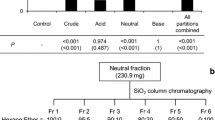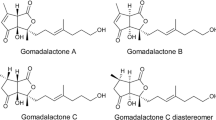Abstract
Little is known of the reproductive behavior of longhorned beetles (Coleoptera: Cerambycidae) in the subfamily Prioninae. Mallodon dasystomus (Say), the hardwood stump borer, is a widely distributed prionine that is native to the southern U.S. Here, we explored the chemically-mediated mating behavior of M. dasystomus, and tested the hypothesis that males recognize females by a contact pheromone. In mating bioassays, all males tested attempted to mate with females only after contacting females with their antennae. Moreover, all males attempted to mate with solvent-washed dead females treated with as little as 0.15 ± 0.03 female equivalents of conspecific cuticular extracts, confirming that compounds on the cuticle of females are essential for mate recognition. Cuticular hydrocarbon profiles of females contained 13 compounds that were not present in profiles of males. Among the female-specific compounds, two co-dominant methyl-branched alkanes, 2-methylhexacosane (2Me-C26) and 2-methyloctacosane (2Me-C28), accounted for 17% of the total hydrocarbons. Our strategy for identifying the contact pheromone was to synthesize and test the bioactivity of female specific compounds, starting with the most abundant. In bioassays, males displayed mating behavior in response to synthetic 2Me-C26 and 2Me-C28 when tested individually. Furthermore, when these compounds were tested in combination, they elicited the full progression of mating behaviors, suggesting that 2Me-C26 and 2Me-C28 make up the contact pheromone. These findings are further evidence of the critical role of contact pheromones in mating systems of longhorned beetles.




Similar content being viewed by others
References
Abrams, S. R., and Shaw, A. C. 1988. Triple bond isomerizations: 2- to 9-decyn-1-ol. Org. Syn. 66:127–131.
Barbour, J. D., Cervantes, D. E., Lacey, E. S., and Hanks, L. M. 2006. Calling behavior in the primitive longhorned beetle Prionus californicus Mots. J. Insect Behav. 19:623–629.
Barbour, J. D., Lacey, E. S., and Hanks, L. M. 2007. Cuticular hydrocarbons mediate mate recognition in a species of longhorned beetle (Coleoptera: Cerambycidae) of the primitive subfamily Prioninae. Ann. Entomol. Soc. Am. 100:333–338.
Buck, M., and Chong, J. M. 2001. Alkylation of 1-alkynes in THF. Tetrahedron Lett. 42:5825–5827.
Burkholder, W. E., Ma, M., Kuwahara, Y., and Matsumura, F. 1974. Sex pheromone of the furniture carpet beetle, Anthrenus flavipes. Can. Entomol. 106:835–839.
Carlson, D. A., Bernier, U. R., and Sutton, B. D. 1998. Elution patterns from capillary GC for methyl-branched hydrocarbons. J. Chem. Ecol. 24:1845–1865.
Cervantes, D. E., Hanks, L. M., Lacey, E. S., and Barbour, J. D. 2006. First documentation of a volatile sex pheromone in a longhorned beetle (Coleoptera: Cerambycidae) of the primitive subfamily Prioninae. Ann Entomol. Soc. Am. 99:718–722.
Corey, E. J., Pyne, S. G., and Su, W. 1983. Total synthesis of leukotriene-B5. Tetrahedron Lett. 24:4883–4886.
Gibbs, A. G. 1998. Water-proofing properties of cuticular lipids. Am. Zool. 38:471–482.
Ginzel, M. D. 2010. Hydrocarbons as contact pheromones of longhorned beetles (Coleoptera: Cerambycidae), pp. 375–389, in G. J. Blomquist, and A. G. Bagnères (eds.). Insect Hydrocarbons: Biology, Biochemistry, and Chemical Ecology. Cambridge University Press, New York.
Ginzel, M. D., and Hanks, L. M. 2003. Contact pheromones as mate recognition cues of four species of longhorned beetles (Coleoptera: Cerambycidae). J. Insect Behav. 16:181–187.
Ginzel, M. D., and Hanks, L. M. 2005. Role of host plant volatiles in mate location for three species of longhorned beetles. J. Chem. Ecol. 31:213–217.
Ginzel, M. D., Blomquist, G. J., Millar, J. G., and Hanks, L. M. 2003a. Role of contact pheromones in mate recognition in Xylotrechus colonus. J. Chem. Ecol. 29:533–545.
Ginzel, M. D., Millar, J. G., and Hanks, L. M. 2003b. (Z)-9-pentacosene—contact sex pheromone of the locust borer, Megacyllene robiniae. Chemoecology 13:135–141.
Ginzel, M. D., Moreira, J. A., Ray, A. M., Millar, J. G., and Hanks, L. M. 2006. (Z)-9-Nonacosene - major component of the contact sex pheromone of the beetle Megacyllene caryae. J. Chem. Ecol. 32:435–451.
Hammack, L., and Burkholder, W. E. 1981. Calling behaviour in female Trogoderma granarium Everts. J. Stored Prod. Res. 17:25–29.
Hanks, L. M. 1999. Influence of the larval host plant on reproduction strategies of cerambycid beetles. Annu. Rev. Entomol. 44:483–505.
Hanks, L. M., Millar, J. G., and Paine, T. D. 1996. Mating behavior of the eucalyptus longhorned borer (Coleoptera: Cerambycidae) and the adaptive significance of long “horns”. J. Insect Behav. 9:383–393.
Lacey, E. S., Ginzel, M. D., Millar, J. G., and Hanks, L. M. 2008. 7-methylheptacosane is a major component of the contact sex pheromone of the cerambycid beetle Neoclytus acuminatus acuminatus. Physiol. Entomol. 33:209–216.
Linsley, E. G. 1962. The Cerambycidae of North America. Part II. Taxonomy and classification of the Parandrinae, Prioninae, Spondylinae, and Aseminae. Univ. Calif. Publ. Entomol. 19:1–102.
Linsley, E. G. and Chemsak, J. A. 1997. The Cerambycidae of North America, Part VIII: Bibliography, Index, and Host Plant Index. Univ. Calif. Publ. Entomol. 117:1–534.
Monné, M. A. and Hovore, F. T. 2005. Checklist of the Cerambycidae, or Longhorned Wood-boring Beetles (Coleoptera), of the Western Hemisphere. BioQuip Products, Rancho Domingquez, CA.
Nelson, D. R. 1993. Methyl-branched lipids in insects, pp. 271–315 in Insect Lipids: Chemistry, Biochemistry, and Biology. Stanley-Samuelson, D. W. and Nelson, D. R. (eds.). University of Nebraska Press, Lincoln, NE.
Nelson, D. R. and Blomquist, G. J. 1995. Insect waxes, pp. 1–90 in Hamilton, R. J. (ed.). Waxes: Chemistry, Molecular Biology, and Function. The Oily Press, Dundee, Scotland.
Nishiguchi, T., Hayakawa, S., Hirasaka, Y., and Saitoh, M. 2000. Selective monotetrahydropyranylation of 1,n-diols catalyzed by aqueous acids. Tetrahedron Lett. 41:9843–9846.
Rodstein, J., Mcelfresh, J. S., Barbour, J. D., Ray, A. M., Hanks, L. M., and Millar, J. G. 2009. Identification and synthesis of a female-produced sex pheromone for the cerambycid beetle Prionus californicus. J. Chem. Ecol. 35:590–600.
Sokal, R. R. and Rohlf, F. J., 1995. Biometry, 3 rd ed. W. H. Freeman and Co., New York.
Solomon, J. D. 1995. Guide to Insect Borers of North American Broadleaf Trees and Shrubs. Agric. Handbk. 706, Washington, DC: U.S. Department of Agriculture, Forest Service.
StatSoft, INC. 2005. STATISTICA (data analysis software system), version 7.1. www.statsoft.com.
Wang, S. and Zhang, A. 2007. A Facile And efficient syntheses of (3Z,6Z,9Z)-3,6,9-nonadecatriene and homologues: Pheromone and attractant components of Lepidoptera. J. Ag. Food Chem. 44:6929–6932.
Yanega, D. 1996. Field Guide to Northeastern Longhorned Beetles (Coleoptera: Cerambycidae). Illinois Natural History Survey, Champaign, Illinois.
Acknowledgments
We thank Corey Wilkins and Aaron Lancaster for assistance rearing the beetles and Jonathan Larson for assistance in conducting bioassays. We appreciate funding support from Purdue University Department of Entomology, the USDA Forest Service (agreement no. 08-JV-11330127-076), and the U.S. Fish and Wildlife Service (Lower Mississippi Valley Joint Venture, Agreement no. 06-IA-11330127-189, managed by Bill Uihlein), and Southeast Region (Agreement no. 07-IA-11330127-171, managed by Janet Ertel). We are grateful to the following individuals and their institutions for permission to work on their lands and logistical support collecting beetles: Ralph Pearce, Delta National Forest; Martin Blaney, David Luker, and Andy VanHorn, Arkansas Game and Fish Commission; Rodney Wishard, Mike Staten, and Gene Holland, Anderson-Tully Company; David Linden, Yazoo National Wildlife Refuge and Becky Rosamond, Dahomey National Wildlife Refuge. This work was in partial fulfillment of an MS degree for A. E. S. from Purdue University.
Author information
Authors and Affiliations
Corresponding author
Rights and permissions
About this article
Cite this article
Spikes, A.E., Paschen, M.A., Millar, J.G. et al. First Contact Pheromone Identified for a Longhorned Beetle (Coleoptera: Cerambycidae) in the Subfamily Prioninae. J Chem Ecol 36, 943–954 (2010). https://doi.org/10.1007/s10886-010-9837-8
Received:
Revised:
Accepted:
Published:
Issue Date:
DOI: https://doi.org/10.1007/s10886-010-9837-8




